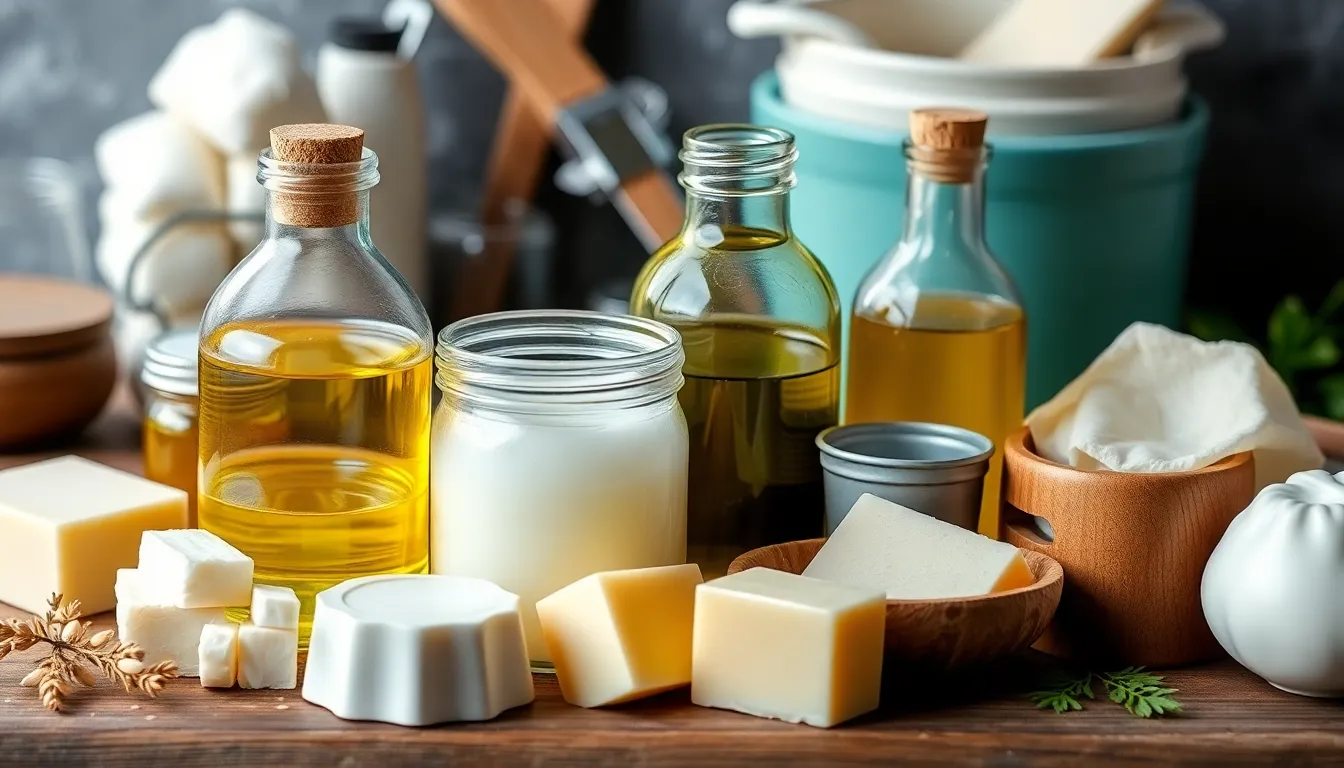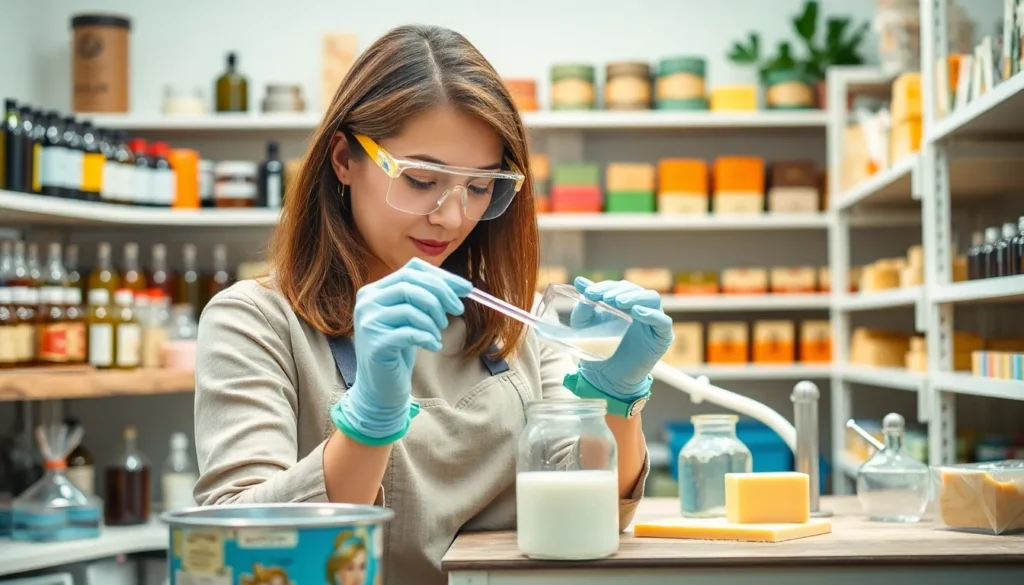Ever wondered how that delightful bar of soap transforms from a gloppy mess into a cleansing powerhouse? Say hello to saponification, the magical process that turns fats and oils into soap. It’s like alchemy for cleanliness, and it’s time to dive into the bubbly world of chemistry that keeps us fresh and fabulous.
Table of Contents
ToggleUnderstanding Saponization
Saponization transforms fats and oils into soap through a chemical reaction. This process is essential for soap-making and serves as a crucial method for cleanliness.
Definition of Saponization
Saponization refers to the reaction between a fat or oil and a strong base, typically sodium hydroxide or potassium hydroxide. This reaction produces fatty acid salts, commonly known as soap, and glycerol as a byproduct. Timing and temperature during saponization affect the final product’s quality. The reaction is exothermic, meaning it releases heat, which assists in achieving the necessary temperature for proper saponification. Different oils yield unique textures and fragrances, allowing for diverse soap products.
Historical Background
Saponization traces back to ancient civilizations. Babylonians used ash and animal fats to create soaps around 2800 BCE. Greeks and Romans expanded on this technique, using natural ingredients for skin and hair care. In the Middle Ages, soap-making became a craft in Europe, with craftsmen sharing techniques across regions. The invention of the chemical process in the 19th century revolutionized soap production, enabling large-scale manufacturing. Advancements in chemistry further enhanced formulations, leading to the diverse range of soaps available today.
The Saponization Process

Saponization transforms fats and oils into soap through a chemical reaction with a strong base. Understanding this process requires knowledge of its ingredients and the underlying chemistry.
Ingredients Used
Fats and oils are the primary ingredients in saponization. Animal fats, such as tallow and lard, provide essential properties, while plant oils like olive and coconut enhance texture and fragrance. Sodium hydroxide serves as the strong base for solid soaps. Potassium hydroxide functions similarly for liquid soaps. Additives, including essential oils, fragrances, and colorants, enhance the final product. Each ingredient contributes unique qualities, making the choice crucial for the desired soap characteristics.
The Chemical Reaction
The chemical reaction in saponization involves hydrolysis. This reaction occurs when fats or oils, which are triglycerides, react with sodium or potassium hydroxide. During hydrolysis, the ester bonds in triglycerides break, resulting in fatty acid salts and glycerol. The process requires careful control of temperature and timing to ensure complete reaction. Effective saponization results in a natural soap with properties based on the initial oils used. Understanding these details enhances the ability to create high-quality soap tailored to specific needs.
Applications of Saponization
Saponization has several practical applications, particularly in producing soap and biodiesel.
In Soap Making
In soap making, saponization is essential for transforming oils and fats into functioning soap. The chemical reaction creates fatty acid salts, forming the soap base. Different oils contribute various properties to the final product, enhancing texture and scent. Producers often utilize precise measurements of sodium hydroxide to achieve desired qualities. Natural additives, including essential oils and colorants, can further customize the soap. Crafting unique soaps appeals to consumers seeking specialized items. Effectively controlling temperature and time ensures a complete reaction, resulting in superior quality.
In Biodiesel Production
Saponization also plays a crucial role in biodiesel production. This process converts triglycerides in fats into fatty acid methyl esters (FAME) through a reaction with an alcohol, typically methanol. Producers use catalyst substances during the reaction to speed up the process. Biodiesel made from this reaction offers a renewable alternative to petroleum-based fuels. Using animal and vegetable oils ensures sustainability and lowers environmental impact. Its incorporation into the fuel market demonstrates a growing interest in green energy solutions. Overall, saponization is pivotal for sustainable energy and effective soap manufacturing.
Benefits of Saponization
Saponization offers numerous advantages that extend beyond soap-making. These benefits encompass various aspects, including environmental virtues and economic implications.
Environmental Advantages
Saponization significantly contributes to environmental sustainability. Natural ingredients like vegetable oils and animal fats serve as biodegradable alternatives to synthetic soaps. Through this process, producers minimize pollution, as the byproducts are less harmful than those from conventional chemical methods. Various oils used provide unique characteristics, offering effective cleansing without the use of harsh additives. Replacing petroleum-derived products with biodiesel, derived from the saponification of fats, promotes renewable energy solutions. As consumers increasingly prioritize products that are eco-friendly, saponization stands as a key player in fostering a greener planet.
Economic Impact
Saponization plays a vital role in the economy by supporting both local artisans and larger industries. Artisans benefit from producing handcrafted soap, allowing for the creation of niche markets centered around customized products. This process enhances job opportunities within the craft-oriented sector. Large-scale manufacturers also gain from efficient production methods. Saponified products often command higher prices due to their perceived quality and natural ingredients, resulting in increased revenue. Saponization encourages sustainable production practices, aligning economic growth with environmental responsibility.
Challenges and Considerations
Saponification presents various challenges and considerations that affect the outcome of the soap-making process. Ensuring safety and quality control remains paramount throughout.
Safety Precautions
Safety precautions are crucial during saponification. Handling sodium hydroxide requires protective gear such as gloves and goggles. Ingesting or inhaling this strong base can result in serious injuries. Careful measurements of ingredients must take place to prevent chemical imbalances. Ventilated work areas help reduce exposure to fumes produced during the reaction. Keeping a first aid kit nearby empowers quick response in emergencies. Understanding the risks associated with each component enhances safe practices for all soap makers.
Quality Control
Quality control is essential in the saponification process. Monitoring ingredient quality determines the final product’s effectiveness. Testing the pH level of soap ensures neutrality, as improper levels can lead to skin irritation. Evaluating the texture, fragrance, and lather also plays a significant role in quality assessments. Manufacturers often conduct small test batches before mass production to refine their recipes. Regular analysis of finished products guarantees that they meet industry standards and consumer expectations. Consistent quality aligns product offerings with market demands.
Saponification stands as a remarkable process that transforms simple fats and oils into essential soap. This age-old technique not only plays a crucial role in personal hygiene but also paves the way for sustainable practices in energy production. By understanding the chemistry behind saponification, individuals can appreciate the artistry involved in soap-making and the environmental benefits it offers.
With careful attention to detail, artisans can create unique soaps that resonate with consumers seeking quality and sustainability. As the world continues to embrace eco-friendly solutions, the significance of saponification in both the soap industry and biodiesel production will only grow, highlighting its enduring relevance in modern society.



